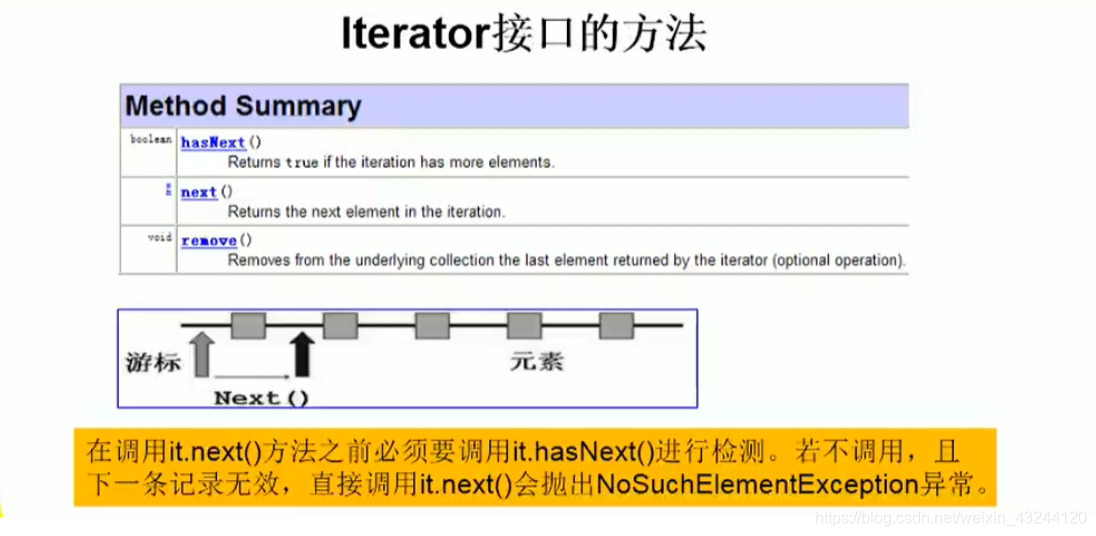一、集合框架的概述
1.集合、数组都是对多个数据进行存储操作的结构,简称java容器
说明:此时的存储指的是内存层面的存储,不涉及持久化的操作(.txt .jpg .avi 数据库等等)
2.1数组在存储多个数据方面的特点:
① 一旦初始化以后,其长度就固定了
② 数据一旦定义好,其元素的类型也就确定了,我们也只能操作指定的类型数据了。
③ 比如 String[] arr,int[] arr1,Object[] arr2
2.1数组在存储多个数据方面的确定:
① 一旦初始化以后,其长度就不可修改了
② 数组中提供的方法非常有限,对于增删改插入数据等操作,非常不便,并且效率不高。
③ 获取数组中的实际元素的个数的需求,数组没有现成的属性或者方法可以使用
④ 数组的特点:有序,可以重复,对于无序,不可重复的需求,不能满足
二、集合框架—主要使用

java集合可以分为Collection和Map两种体系
Collection接口:单列数据,定义了存取一个一个对象的集合
1.List:存储有序,可重复的数据 --“动态数组”
ArrayList、LinkedList、Vector
2.Set:存储无序,不可重复的集合,底层为链表
HashSet、LinkedHashSet、TreeSet
Map接口:双列数据,保存具有映射关系"key-value对"的数据
HashMap、LinkedHashMap、TreeMap、Hashtable、Properties
三、Collection接口中的方法使用
自定义一个类(Person ),用于数据的测试
public class Person implements Comparable {
public String name;
public int age;
public String getName() {
return name;
}
public void setName(String name) {
this.name = name;
}
public int getAge() {
return age;
}
public void setAge(int age) {
this.age = age;
}
@Override
public String toString() {
return "Person{" +
"name='" + name + '\'' +
", age=" + age +
'}';
}
public Person() {
}
public Person(String name, int age) {
this.name = name;
this.age = age;
}
//重写equals()方法,比较判断contains()中的比较问题
@Override
public boolean equals(Object o) {
if (this == o) return true;
if (o == null || getClass() != o.getClass()) return false;
Person person = (Person) o;
if (age != person.age) return false;
return name != null ? name.equals(person.name) : person.name == null;
}
@Override
public int hashCode() {
int result = name != null ? name.hashCode() : 0;
result = 31 * result + age;
return result;
}
//按照姓名从小到大排列,年龄从小到大排序
@Override
public int compareTo(Object o) {
if (o instanceof Person){
Person person = (Person)o;
// return this.name.compareTo(person.name);
int compare = this.name.compareTo(person.name);
if (compare !=0){
return compare;
}else {
return Integer.compare(this.age,person.age);
}
}else {
throw new RuntimeException("输入的类型不匹配!");
}
}
}
Collection的常用方法列举
1.add(Object o); 讲元素o添加到集合coll中
2.size():获取添加的元素个数
3.addAll(Collection coll):将coll集合中的元素添加到当前集合中
4.clear():清空集合元素
5.isEmpty():判断当前集合是否为空
6.contains(Object o):判断当前集合是否包含obj
7.containsAll(Collection coll1):判断形参coll1中的所有元素是否在当前集合中
8.remove(Object o):从当前集合中删除obj元素
9.removeAll(Collection coll1):从当前集合中移除coll1中的所有元素
10.retainAll():获取当前集合和coll1集合的交集,并返回当前集合(保留一样的,去掉不一样的)
11.equals(Object o):要想返回true,现需要当前集合和方法的形参集合的元素相同(判断当前集合和形参Object的值是否相同)
12.hashCode()返回当前对象的哈希值
13.集合 —>数组:toArray()
14.iterator():返回Iterator接口的实例,用于遍历集合元素
Collection coll = new ArrayList();
//1.add(Object o); 讲元素o添加到集合coll中
coll.add("aa");
coll.add("bb");
coll.add("cc");
coll.add(123);//自动装箱
coll.add(new Date());
//2.size():获取添加的元素个数
System.out.println(coll.size());//4
Collection coll1 = new ArrayList();
//3.addAll(Collection coll):将coll集合中的元素添加到当前集合中
coll1.add(456);
coll1.add("abc");
coll.addAll(coll1);
System.out.println(coll.size());//6
//4.clear():清空集合元素
coll.clear();//0
//5.isEmpty():判断当前集合是否为空
System.out.println(coll.isEmpty());//true
@Test
public void test(){
Collection coll = new ArrayList();
coll.add(123);
coll.add(456);
coll.add(new String("Tom"));
coll.add(false);
coll.add(new Person("Tom",20));
Person p = new Person("Jerry",20);
coll.add(p);
//6.contains(Object o):判断当前集合是否包含obj
//我们会在判断时调用obj所在对象类的equals()
boolean contains = coll.contains(123);
System.out.println(contains);
System.out.println(coll.contains(p));//true
System.out.println(coll.contains(new Person("Jerry",20)));//true
//7.containsAll(Collection coll1):判断形参coll1中的所有元素是否在当前集合中
Collection coll1 = Arrays.asList(123,456,789);
System.out.println(coll.containsAll(coll1));
}
@Test
public void test1(){
//8.remove(Object o):从当前集合中删除obj元素
Collection coll = new ArrayList();
coll.add(123);
coll.add(456);
coll.add(new String("Tom"));
coll.add(false);
coll.add(new Person("Tom",20));
coll.remove(123);
System.out.println(coll);//[456, Tom, false, Person{name='Tom', age=20}]
boolean remove = coll.remove(1234);
System.out.println(remove);//false
boolean tom = coll.remove(new Person("Tom", 20));
System.out.println(tom);//true
//9.removeAll(Collection coll1):从当前集合中移除coll1中的所有元素
Collection coll1 = Arrays.asList(123,456);
coll.removeAll(coll1);
System.out.println(coll);//[Tom, false, Person{name='Tom', age=20}]
}
@Test
public void test2(){
Collection coll = new ArrayList();
coll.add(123);
coll.add(456);
coll.add(new String("Tom"));
coll.add(false);
coll.add(new Person("Tom",20));
//10.retainAll():获取当前集合和coll1集合的交集,并返回当前集合(保留一样的,去掉不一样的)
// Collection coll1 = Arrays.asList(123,456,789);
// coll.retainAll(coll1);
//System.out.println(coll);//[123, 456]
//11.equals(Object o):要想返回true,现需要当前集合和方法的形参集合的元素相同
// (判断当前集合和形参Object的值是否相同)
Collection coll1 = new ArrayList();
coll1.add(123);
coll1.add(456);
coll1.add(new String("Tom"));
coll1.add(false);
coll1.add(new Person("Tom",20));
//若现在集合中的元素交换位置的话,就会是false,因为(new ArrayList())的要考虑顺序问题
System.out.println(coll.equals(coll1));//true
}
@Test
public void test3(){
Collection coll = new ArrayList();
coll.add(123);
coll.add(456);
coll.add(new String("Tom"));
coll.add(false);
coll.add(new Person("Tom",20));
//12.hashCode()返回当前对象的哈希值
System.out.println(coll.hashCode());//239446066
//13.集合 --->数组:toArray()
Object[] arr = coll.toArray();
for (int i = 0; i < arr.length; i++) {
System.out.print(arr[i]+"\t");//123 456 Tom false Person{name='Tom', age=20}
}
//拓展:数据 ---> 集合:调用ArrayList的静态方法asList()
List<String> list = Arrays.asList(new String[]{"AA", "BB", "CC"});
System.out.println(list);//[AA, BB, CC]
//将其识别为一个元素,不是两个
List ints = Arrays.asList(new int[]{123, 456, 789});
System.out.println(ints);//[[I@4f2410ac] .size()的话,值为1
//14.iterator():返回Iterator接口的实例,用于遍历集合元素 ,在IteratorTest使用
}
四、迭代器的使用
1.集合元素的遍历操作,使用迭代器Iterator接口(是设计模式中的一种),主要用于遍历Collection集合中元素

迭代器模式:提供一种方法访问一个容器(container)对象中的各个元素,而又不暴露该对象的内部细节
这种模式就是为容器而生,容器里面有很多对象(集合,数组)
1.集合的方法 hasNext() 和 next()
2.集合中对象每次调用iterator()方法都会得到一个全新的迭代器对象,
默认下标都在第一个元素之前
3.内部定义了remove(),可以在遍历的时候,删除集合中当元素,此方法不同于集合直接调用remove()
public class IteratorTest {
@Test
public void test() {
Collection coll = new ArrayList();
coll.add(123);
coll.add(456);
coll.add(new String("Tom"));
coll.add(false);
coll.add(new Person("Tom", 20));
Iterator iterator = coll.iterator();
//方式一:取决于集合中有多少个元素
//next():①指针下移 ②将下移以后集合位置上的元素返回
// System.out.println(iterator.next());
// System.out.println(iterator.next());
// System.out.println(iterator.next());
// System.out.println(iterator.next());
// System.out.println(iterator.next());
//抛异常,没有下一个元素了 java.util.NoSuchElementException
// System.out.println(iterator.next());
//方式二:不推荐
// for (int i = 0; i < coll.size(); i++) {
// System.out.println(iterator.next());
// }
//方式三:推荐
//hasNext():判断是否还有下一个元素,有true,没有false
while (iterator.hasNext()){
//next():①指针下移 ②将下移以后集合位置上的元素返回
System.out.print(iterator.next()+"\t");//123 456 Tom false Person{name='Tom', age=20}
}
}
@Test
public void test1(){
Collection coll = new ArrayList();
coll.add(123);
coll.add(456);
coll.add(new String("Tom"));
coll.add(false);
coll.add(new Person("Tom", 20));
//错误发生一:判断为空时,输出的是下一条的数据信息
// Iterator iterator = coll.iterator();
// while (iterator.next() !=null){
// System.out.println(iterator.next());//456 false
// }
//错误发生二:coll.iterator()会返回新的iterator对象,在hasNext就一直是第一个元素
while (coll.iterator().hasNext()){
System.out.println(coll.iterator().next());//123循环输出
}
}
//测试remove()
@Test
public void test2(){
Collection coll = new ArrayList();
coll.add(123);
coll.add(456);
coll.add(new String("Tom"));
coll.add(false);
coll.add(new Person("Tom", 20));
Iterator iterator = coll.iterator();
//删除集合中的数据
while (iterator.hasNext()){
//如何还没有调用next(),就删除会抛异常,因为现在集合为空,没有执行next,指针不在集合中
// iterator.remove();
Object next = iterator.next();
if ("Tom".equals(next)){
iterator.remove();
}
}
//需要重新获取一个新的对象
iterator = coll.iterator();
//重新遍历集合
while (iterator.hasNext()){
System.out.print(iterator.next() +"\t");//123 456 false Person{name='Tom', age=20}
}
}
}
五、增强for循环
jdk5.0新增foreach循环,用于遍历集合,数组
public class ForTest {
@Test
public void test(){
Collection coll = new ArrayList();
coll.add(123);
coll.add(456);
coll.add(new String("Tom"));
coll.add(false);
coll.add(new Person("Tom", 20));
//for(集合元素类型 局部遍历 :集合对象)
for (Object obj : coll){//内部调用任然是迭代器
System.out.println(obj);
}
}
//练习题
@Test
public void test1(){
String[] str = new String[]{"MM","MM","MM"};
//普通的for循环,改变String的值
// for (int i = 0; i < str.length; i++) {
// str[i] = "GG";
// }
//增强for循环,新增变量String s:不会改变原来的值,重新赋了一个值
for (String s :str){
s = "GG";
}
for (int i = 0; i < str.length; i++) {
System.out.println(str[i]);
}
}
}
